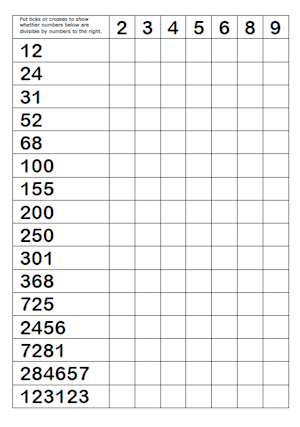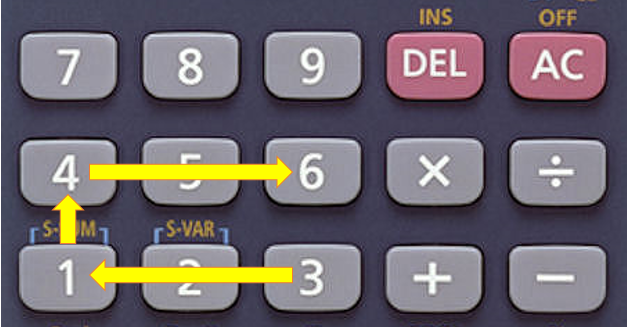 |
Divisibility TestPractise using the quick ways to spot whether a number is divisible by the digits 2 to 9. |
 |
Divisibility TestPractise using the quick ways to spot whether a number is divisible by the digits 2 to 9. |
Tick boxes to show where the black number is exactly divisible by the red number.
Tick the box in the 'None' column if the black number is not divisible by any of the red numbers.
If you are confident with this concept try the Delightfully Divisible challenge.
InstructionsTry your best to answer the questions above. Type your answers into the boxes provided leaving no spaces. As you work through the exercise regularly click the "check" button. If you have any wrong answers, do your best to do corrections but if there is anything you don't understand, please ask your teacher for help. When you have got all of the questions correct you may want to print out this page and paste it into your exercise book. If you keep your work in an ePortfolio you could take a screen shot of your answers and paste that into your Maths file. |
||
|
|
||
|
|

|
More Activities: |
|
Mathematicians are not the people who find Maths easy; they are the people who enjoy how mystifying, puzzling and hard it is. Are you a mathematician? Comment recorded on the 8 May 'Starter of the Day' page by Mr Smith, West Sussex, UK: "I am an NQT and have only just discovered this website. I nearly wet my pants with joy. Comment recorded on the 28 May 'Starter of the Day' page by L Smith, Colwyn Bay: "An absolutely brilliant resource. Only recently been discovered but is used daily with all my classes. It is particularly useful when things can be saved for further use. Thank you!" |
Each month a newsletter is published containing details of the new additions to the Transum website and a new puzzle of the month. The newsletter is then duplicated as a podcast which is available on the major delivery networks. You can listen to the podcast while you are commuting, exercising or relaxing. Transum breaking news is available on Twitter @Transum and if that's not enough there is also a Transum Facebook page. |
|
AnswersThere are answers to this exercise but they are available in this space to teachers, tutors and parents who have logged in to their Transum subscription on this computer. A Transum subscription unlocks the answers to the online exercises, quizzes and puzzles. It also provides the teacher with access to quality external links on each of the Transum Topic pages and the facility to add to the collection themselves. Subscribers can manage class lists, lesson plans and assessment data in the Class Admin application and have access to reports of the Transum Trophies earned by class members. If you would like to enjoy ad-free access to the thousands of Transum resources, receive our monthly newsletter, unlock the printable worksheets and see our Maths Lesson Finishers then sign up for a subscription now: Subscribe |
||
Go MathsLearning and understanding Mathematics, at every level, requires learner engagement. Mathematics is not a spectator sport. Sometimes traditional teaching fails to actively involve students. One way to address the problem is through the use of interactive activities and this web site provides many of those. The Go Maths page is an alphabetical list of free activities designed for students in Secondary/High school. Maths MapAre you looking for something specific? An exercise to supplement the topic you are studying at school at the moment perhaps. Navigate using our Maths Map to find exercises, puzzles and Maths lesson starters grouped by topic. | ||
Teachers | ||
|
If you found this activity useful don't forget to record it in your scheme of work or learning management system. The short URL, ready to be copied and pasted, is as follows: |
Alternatively, if you use Google Classroom, all you have to do is click on the green icon below in order to add this activity to one of your classes. |
It may be worth remembering that if Transum.org should go offline for whatever reason, there is a mirror site at Transum.info that contains most of the resources that are available here on Transum.org. When planning to use technology in your lesson always have a plan B! |
|
Do you have any comments? It is always useful to receive feedback and helps make this free resource even more useful for those learning Mathematics anywhere in the world. Click here to enter your comments. |
||
A number is divisible by 2 if its last digit is even (0,2,4,6 or 8)
A number is divisible by 3 if the sum of its digits is divisible by 3.
A number is divisible by 4 if the number's last two digits are divisible by 4.
A number is divisible by 5 if its last digit is a 0 or 5.
A number is divisible by 6 if it is divisible by 2 and 3 (see rules above).
A number is divisible by 7 if 5 times the last digit added to the number made from the other digits is divisible by 7.
A number is divisible by 8 if the last three digits form a number that is divisible 8.
A number is divisible by 9 if the sum of the digits is divisible by 9.
A number is divisible by 10 if its last digit is 0.
A number is divisible by 11 if the alternating sum of its digits is divisible by 11. Alternating sum means a-b+c-d+... – m
A number is divisible by 12 if it is divisible by 3 and 4.
The projectable version of the divisibility tests can be found here: Divisibility Tests 2-12
There is a printable worksheet to go with this activity.

The divisibility test for 7 is thanks to a 12-year old pupil, Chika Ofili, from Westminster School. You can read more about it here.
Answers to this exercise are available lower down this page when you are logged in to your Transum account. If you don’t yet have a Transum subscription one can be very quickly set up if you are a teacher, tutor or parent.
Close

Matrix simulation redesigned by Arunkumar Gudelli
Transum,
Saturday, October 27, 2018
"Type a four digit number on to your calculator. The keys used to type in this number must form a rectangle. Each digit should be one of the corners of this rectangle and you can work your way around this rectangle either clockwise or anticlockwise starting at any corner of the rectangle.

After you have created many four-digit numbers using this method you should see that all of the numbers have something in common. They are all divisible by the same prime number. What is that prime number? "